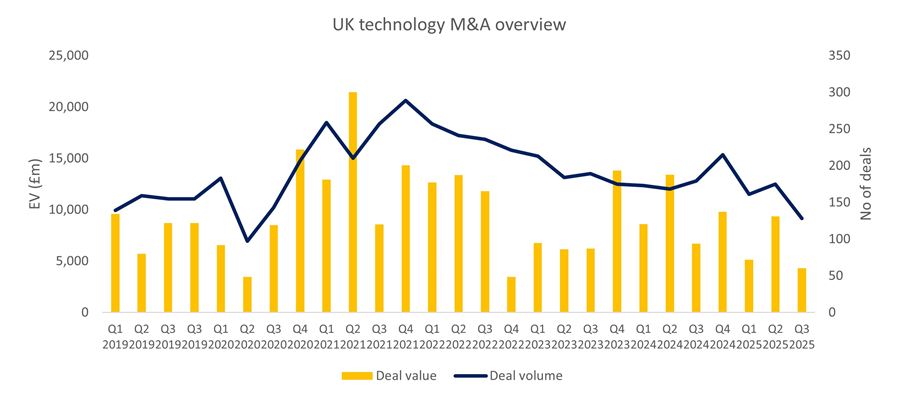
The third quarter of 2025 saw subdued deal activity, in part reflecting the traditional holiday season slowdown, but also closed with cautious optimism emerging in the UK technology sector. Beyond the seasonal lull, market sentiment remained measured, though several long-term investment announcements signalled growing confidence in the UK's digital future. Most notably, the UK government secured £150 billion of US investment from firms including Blackstone and tech giants Microsoft and Google. The deal will see the UK and US cooperate in key areas including hyperscale data centres, AI, quantum computing and nuclear power, with the potential to generate thousands of UK jobs at a time when growth and job creation remain challenging. Another positive piece of news is that Google and NatWest have announced a partnership with the Department for Business and Trade to help UK SME leaders implement AI tools. This comes off the back of a survey suggesting 59% of British SME owners have paused AI tool implementation ideas due to (ironically) time constraints. This is a positive development in supporting business owners to make the right investments to improve products, services and operating margins.
Mirroring UK M&A activity, growth in the UK economy stalled in Q3 2025, with the ONS reporting no growth at all during July and August. Inflation, while trending lower, remains above the Bank of England's 2% target, with the latest CPI reading of 3.8%, prompting policymakers to maintain a cautious stance with just one rate cut in the quarter. Further rate cuts are anticipated in 2026, however. The net result is that business confidence remains fragile, as higher financing costs and lower growth continue to weigh on investment appetite. The Chancellor’s pre-Budget speech will not have provided any encouragement to the markets.
Quarter on quarter, deal volumes fell 27% to 128, while deal values declined 54% to £4.3 billion (largely due to three sizeable transactions closing in Q2). Year on year, the picture was similarly muted, with volumes and values down 28% and 35% respectively. The slow down was more prominent in PE than in trade deals. We suspect the weaker performance reflects the economic uncertainty felt earlier in the year given the lead time on transactions. Encouragingly, early signs are that deal activity has bounced back in October, although we remain cautious given the potential impact of the Autumn Budget.
Highlights
- OpenAI secures over $1 trillion in AI compute commitments:
The AI leader signed landmark agreements with AMD, Nvidia and Oracle, representing one of the largest procurement commitments in tech history. While OpenAI is projected to lose $10 billion this year, the company is betting that this unprecedented scale of computing infrastructure will underpin its path to profitability and cement its position at the forefront of the AI revolution. - A potential turning point for London's IPO market:
After a dismal nine months that saw just three IPOs on the London Stock Exchange, Norway-based software company Visma has provisionally selected London as its listing destination. This would mark a significant vote of confidence in UK capital markets and the domestic tech sector. However, Visma's backer Hg Capital has made it clear the listing remains conditional on UK government and exchange reforms. Questions also linger around valuation, given Visma was last valued at a low-20s EV/EBITDA multiple — a premium that London markets have historically struggled to sustain. - Smart Communications SBO demonstrates premium valuations remain achievable: Communication management software provider Smart Communications sold from Accel-KKR to Cinven for £1.4 billion in a deal estimated at a mid-20s EBITDA multiple, with the company posting consistent double-digit revenue growth. The transaction reinforces that businesses of scale with demonstrable growth opportunities are still commanding strong valuations. The regulated industries client focus and investment into AI are stand out features of the business.
Observations
- Software companies shift focus from growth to profitability: According to Megabuyte's latest analysis, 61% of software companies experienced slower organic growth in Q3, while two out of three demonstrated expanding EBITDA margins (up sharply on last quarter). This trend reflects the more balanced growth-to-margin profile that has become the hallmark of software businesses in recent years, as the sector continues to prioritize sustainable profitability alongside revenue expansion.
- PE-backed buyers dominate transaction activity:
Buyer composition in Q3 showed a notable shift, with PE-backed acquirers accounting for 51% of transactions — up six percentage points from the previous quarter. This represented the largest quarterly change in buyer mix, alongside international buyers at 20%, owner-managed at 12%, private equity (new investments) at 9%, and public companies at 9%. The rising prominence of PE-backed buyers reflects the risk-off environment, where portfolio companies are pursuing bolt-on acquisitions in familiar sectors rather than committing capital to riskier platform investments. We are, however, seeing signs of increased competition for platform investments again, so this buyer mix may swing back in the near term. - Due diligence intensifies as margin for error narrows:
Transaction processes are seeing heightened scrutiny, with an increased preference for vendor assist (i.e. due diligence focused data books and commentary) and full vendor due diligence to support the sale process. In the current environment, buyers are even more sensitive than normal to surprises during due diligence, and sellers must be realistic about budget and forecast figures. This trend underscores the premium placed on transparency and preparation in order to push deals across the line.
Outlook
While deal activity this quarter has been relatively quiet by historical standards, the UK technology sector continues to demonstrate resilience in 2025, with PE buy and build activity and further consolidation in fragmented sectors such as managed service providers and telecoms resellers.
Business confidence remains subdued and an expanding UK budget deficit suggests the Autumn Budget later this month is unlikely to offer much in the way of encouragement to UK business or consumers. We remain optimistic, however, that UK Tech will continue to innovate and adapt, with the committed inbound investment from the US giving the potential for a significant boost.
Interestingly, there were 75 deal completions in October, an increase of 92% over September, suggesting a possible ‘catch up’ in activity following Q3. We will monitor the rest of 2025 with interest, particularly as the market looks to navigate the Budget and run-in to the festive period.
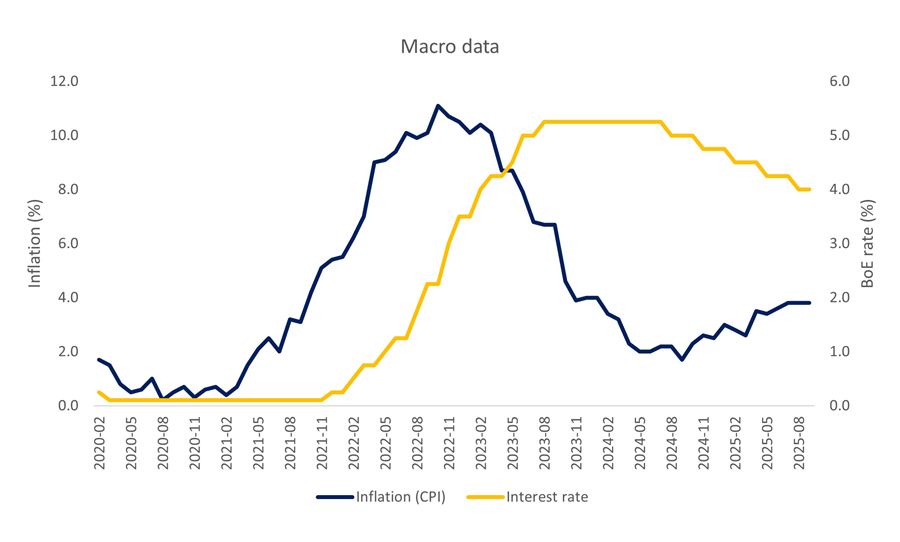
Spotlight on ESG software
ESG compliance has been undergoing a transformation in recent years, from voluntary data capture and reporting to mandatory business-critical processing. The combination of more onerous regulatory requirements (including the UK's Sustainability Disclosure Requirements and TCFD reporting being replaced by UK Sustainability Reporting Standards) and corporate net-zero commitments having to be evidenced through formal transition plans, has created an attractive M&A/investment environment for leading software solutions.
While M&A activity has been fairly low key so far, we expect volumes to pick up over the next five years. Regulatory requirements are only heading in one direction and scalable solutions targeting efficient data capture and reporting are likely to attract further interest, particularly from private equity.
Key active areas of ESG software
Carbon management consolidation: Companies providing emissions measurement and reporting tools as organisations grapple with complex disclosure obligations. Platforms with proven enterprise client bases and robust data verification will be prime targets.
Supply chain ESG solutions: Technology providers offering supplier engagement and sustainable procurement tools, including solutions that integrate with existing ERP systems. The need for this is likely to grow significantly as larger firms seek assurance over social and environmental standards in their supply chains.
Investor ESG Analytics & Disclosure Platforms: Solutions designed for asset managers, private equity firms, and institutional investors to track portfolio-level ESG performance, manage regulatory disclosures (e.g., SFDR, UK SRS, Transition Plans and European Union CSRD), and integrate sustainability metrics into investment decision-making.
Key deals in the sector during 2025 include:
- Third party risk management platform Ethixbase 360, acquired by CGE Partners.
- Carbon emission software business Spherics, acquired by Sage.
- Sustainability platform Greenstone+ acquired by Cority.
- Carbon accounting software (for the logistics industry) Pledge, acquired by Blue Yonder.
Capital markets
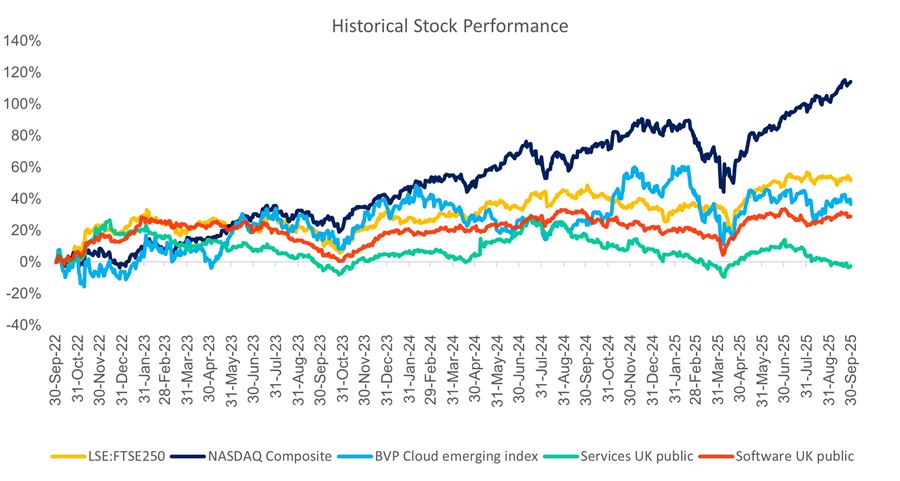
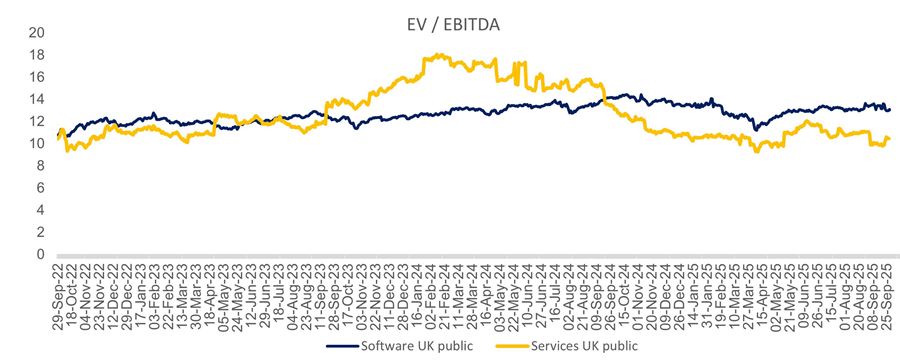
Market Performance
US technology equities continued their strong outperformance, with the Nasdaq-100 (QQQ) advancing 12.6% during the quarter, driven primarily by large-cap technology companies capitalizing on the AI investment cycle.
By contrast, the FTSE 250 suffered a decline of 1.0%. Within UK markets, a notable divergence emerged between sectors: services companies declined 14.4%, while software businesses demonstrated relative resilience with a 2.2% decline.
Valuation Environment
Valuation multiples across our software and services indices remained broadly stable. Software companies traded at an average of 12.8x EBITDA during the quarter (up 0.1x quarter-over-quarter), while services businesses commanded an average of 10.5x EBITDA (up 0.5x quarter-over-quarter). These multiples are subdued however compared to the multiples of the tech heavy Nasdaq, which trades at an average EV/EBITDA of 20x+, fuelled by the AI rally; with a number of news headlines suggesting we may be entering into bubble territory.
SME Performance
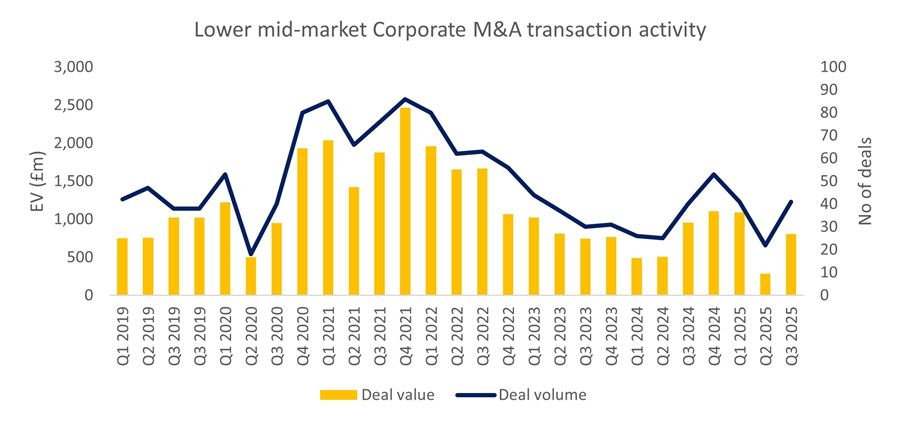
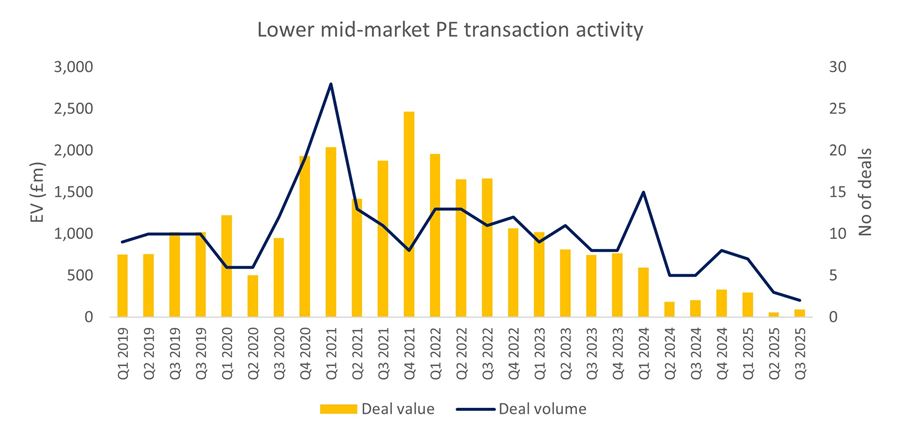
*This does not include deals with no reported deal value
Key highlights
The most active sub-sectors in the lower mid-market this quarter were governance, risk and compliance, retail and leisure and IT consulting, each with five deals. These sub-sectors continue to be some of the most active for deals in a more subdued market.
Trade deals hold up better than PE deals: as noted above, PE backed trade deals (i.e. bolt on activity) were a strong feature of the market in Q3. In a risk-off market, we are not surprised to see fewer PE platform investments in the lower mid-market. The chart above comes with the usual health warning, however, that the data does not include deals without a reported value.
Crowe Activity
Q3 2025 transactions we advised:
- Wilmington plc on its acquisition of RegTech documentation generation software solutions provider, Conversia, S.L.U.
- Your.Cloud on the acquisition of telecoms and IT services provider, Comm-Tech Voice & Data.
Sources for article: Pitchbook, Megabuyte, ONS, Bank of England
Supporting you
Contact us






